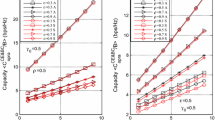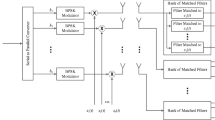Abstract
In this paper a closed form expression for the bit error rate of LDPC–OC system in the presence of interferers is derived over an i.i.d Rayleigh fading channel using message passing algorithm. All interferers are assumed to have equal power. The analysis is done for the case when the number of interferes is more than the number of receive antenna elements. In this paper, analytical results showed that for a BER of 10−2, the LDPC–OC system provides an additional gain of 6.3 dB over OC system alone. Both the systems provide identical diversity gain of 1.2 dB when the number of receive antennas are increased from 5 to 6.





Similar content being viewed by others
References
Gallager, R. G. (1962). Low-density parity-check codes. IRE Transactions on Information Theory, 21(1), 21–28.
MacKay, D. J. C. (1999). Comparison of constructions of irregular Gallager codes. IEEE Transactions on Communication, 47(10), 1449–1451.
Winters, J. H. (1984). Optimum combining in digital mobile radio with co-channel interference. IEEE Journal on Selected Areas in Communication, 2(4), 528–539.
Shah, A., & Haimovich, A. M. (1998). Performance analysis of optimum combining in wireless communications with Rayleigh fading and co-channel interference. IEEE Transactions on Communications, 46(4), 473–479.
Villier, Eric. (1999). Performance analysis of optimum combining with multiple interferers in flat Rayleigh fading. IEEE Communication Letters, 47(10), 503–1510.
Yongpeng, W. U., et al. (2010). New performance results for optimum combining in presence of arbitrary-power interferers and thermal noise. IEICE Transactions on Communications, 93(7), 1919–1922.
Gounai, S., Ohtsuki, T., (2006). Performance analysis of LDPC code with spatial diversity. IEEE 64th Vehicular Technology conference, 1–5.
Sharma, Surbhi, & Khanna, R. (2009). Analysis of LDPC with optimum combining. International Journal of Electronics, 96(8), 803–811.
Richardson, T. J., Shokrollahi, M. A., & Urbanke, R. L. (2001). Design of capacity-approaching irregular low-density parity-check codes. IEEE transactions on Information Theory, 47(2), 619–637.
Brink, S. T. (2001). Convergence behavior of iteratively decoded parallel concatenated codes. IEEE Transactions on Communications, 49(10), 1727–1737.
Hou, J., Siegel, P. H., & Milstein, L. B. (2001). Performance analysis and code optimization of low density parity-check codes on Rayleigh fading channels. IEEE Journal on Selected Areas in Communication, 19(5), 924–934.
Lehmann, F., & Maggio, G. M. (2003). Analysis of the iterative decoding of LDPC and product codes using the Gaussian approximation. IEEE Transactions on Information Theory, 49(11), 2993–3000.
Gradshteyn, S., & Ryzhik, M. (2007). Tables of integrals, series and products (pp. 337–340). New York: Academic Press.
Acknowledgments
This study is supported by UGC and AICTE India vide letter no 31-1(pun)/sr-2008 TU and letter number 8023/BOR/RID/RPS-105/2008-2009.
Author information
Authors and Affiliations
Corresponding author
Rights and permissions
About this article
Cite this article
Sharma, S., Khanna, R. Upper Bounds on Overloaded LDPC–Optimum Combinied System Over Rayleigh Fading Channel. Wireless Pers Commun 83, 1331–1339 (2015). https://doi.org/10.1007/s11277-015-2452-9
Published:
Issue Date:
DOI: https://doi.org/10.1007/s11277-015-2452-9




